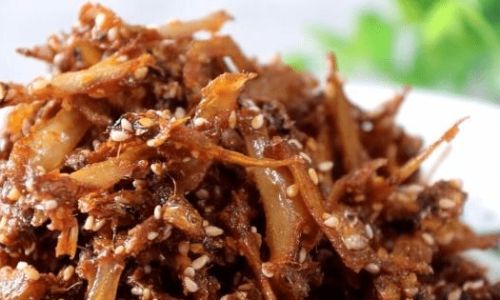Introduction

Fish jerky is a delightful snack that combines the savory taste of dried fish with a variety of spices and herbs. Among the various flavors, cumin fish jerky stands out due to its unique aroma and flavor profile. Cumin, a popular spice known for its warm, earthy taste, adds a depth of flavor that complements the natural taste of fish. In this comprehensive guide, we will explore how to make delicious cumin fish jerky from scratch. We’ll cover everything from selecting the right fish, preparing it properly, to marinating and drying it to perfection. By following these steps, you’ll be able to create a batch of cumin fish jerky that is both tasty and satisfying.
Chapter 1: Selecting the Right Fish
The first step in making cumin fish jerky is selecting the right type of fish. The quality and type of fish you choose will significantly impact the final taste and texture of your jerky. Here are some key factors to consider:
1 Fat Content
Fish with a moderate fat content are ideal for making jerky. Fatty fish like salmon can be used, but they may require additional drying time to prevent spoilage. On the other hand, lean fish like cod or tilapia dry more quickly and are less prone to rancidity.
2 Texture
The texture of the fish is also important. Firm-fleshed fish hold up better during the drying process, resulting in a chewier, more satisfying jerky. Examples of firm-fleshed fish include tuna, halibut, and swordfish.
3 Freshness
Always use fresh fish when making jerky. Fresh fish has a cleaner, more pleasant taste and is less likely to spoil during the drying process. If you can’t find fresh fish, frozen fish that has been properly thawed can also be used.
4 Sustainability
Consider the sustainability of the fish you choose. Opt for fish that are caught or farmed in environmentally responsible ways to minimize your impact on marine ecosystems.
Chapter 2: Preparing the Fish
Once you’ve selected the right fish, it’s time to prepare it for jerky making. Here’s a step-by-step guide to preparing your fish:
1 Cleaning the Fish
Start by cleaning the fish thoroughly. Remove any scales, fins, and internal organs. Rinse the fish under cold running water to remove any blood or debris. Pat the fish dry with paper towels to remove excess moisture.
2 Filleting the Fish
Next, fillet the fish. Use a sharp knife to cut the fish into thin, even slices. The thickness of the slices will depend on your personal preference, but generally, slices that are about 1/4 to 1/2 inch thick work well for jerky.
3 Removing Bones and Skin

If desired, remove any bones and skin from the fish slices. This is especially important if you plan to eat the jerky without further processing, as bones and skin can be difficult to chew.
4 Curing (Optional)
Curing the fish is an optional step that can help preserve it and enhance its flavor. To cure the fish, mix a small amount of salt and sugar (about 1/4 cup of each per pound of fish) and rub it into the fish slices. Let the fish sit in the refrigerator for a few hours or overnight. Rinse off the cure before proceeding to the next step.
Chapter 3: Marinating the Fish
Marinating the fish is a crucial step in making cumin fish jerky. The marinade will flavor the fish and help it hold up during the drying process. Here’s a basic marinade recipe and instructions for marinating the fish:
1 Marinade Ingredients
- 1/4 cup olive oil or vegetable oil
- 1/4 cup soy sauce or tamari (for a gluten-free option)
- 2 tablespoons Worcestershire sauce (optional, for added flavor)
- 2 tablespoons honey or maple syrup (for sweetness)
- 2 tablespoons lemon juice or lime juice (for tanginess)
- 2 tablespoons ground cumin
- 1 tablespoon smoked paprika (optional, for added smokiness)
- 1 tablespoon garlic powder
- 1 tablespoon onion powder
- 1 teaspoon black pepper
- 1 teaspoon salt (optional, if you didn’t cure the fish)
2 Preparing the Marinade
In a large bowl or container, whisk together all the marinade ingredients until well combined. Adjust the seasoning to taste, adding more cumin or other spices if desired.
3 Marinating the Fish
Add the fish slices to the marinade, ensuring they are fully submerged. Cover the container and let the fish marinate in the refrigerator for at least 2 hours, preferably overnight. The longer the fish marinates, the more flavor it will absorb.
Chapter 4: Drying the Fish
Drying the fish is the final step in making cumin fish jerky. There are several methods you can use to dry the fish, including oven drying, dehydrator drying, and air drying. Here’s a guide to each method:
1 Oven Drying
- Preheat your oven to its lowest setting, usually around 150-170°F (65-75°C).
- Line a baking sheet with parchment paper or a silicone baking mat.
- Arrange the marinated fish slices on the baking sheet in a single layer, ensuring they are not overlapping.
- Place the baking sheet in the oven and let the fish dry for 3-6 hours, depending on the thickness of the slices and your desired texture.
- Check the fish periodically, flipping the slices over halfway through the drying process to ensure even drying.
- The fish is done when it is dry and slightly tacky to the touch, but not brittle.
2 Dehydrator Drying
- Set your dehydrator to its lowest setting, usually around 135°F (55°C).
- Arrange the marinated fish slices on the dehydrator trays in a single layer.
- Place the trays in the dehydrator and let the fish dry for 4-8 hours, depending on the thickness of the slices and your desired texture.
- Check the fish periodically, rotating the trays halfway through the drying process to ensure even drying.
- The fish is done when it is dry and slightly tacky to the touch, but not brittle.
3 Air Drying
- Air drying is a more traditional method that requires patience and the right conditions.
- String the marinated fish slices onto drying racks or hang them from hooks.
- Place the racks or hooks in a well-ventilated area where the temperature is between 60-80°F (15-25°C) and the humidity is low.
- Let the fish dry for several days, depending on the thickness of the slices and the weather conditions.
- Check the fish daily, bringing it indoors if rain or high humidity is forecasted.
- The fish is done when it is dry and slightly tacky to the touch, but not brittle.
Chapter 5: Storing Your Cumin Fish Jerky
Once your cumin fish jerky is done, it’s important to store it properly to maintain its freshness and flavor. Here are some tips for storing your jerky:
1 Cooling

Let the jerky cool completely before storing it. This will help prevent condensation and keep the jerky crisp.
2 Airtight Containers
Store the jerky in airtight containers or zip-top plastic bags. This will help prevent moisture and air from getting in, which can cause the jerky to spoil.
3 Refrigeration
For long-term storage, refrigerate the jerky in an airtight container. It will keep for several weeks in the refrigerator.
4 Freezing
For even longer storage, freeze the jerky in an airtight container or zip-top plastic bag. It will keep for several months in the freezer.
Chapter 6: Serving and Enjoying Your Cumin Fish Jerky
Now that you’ve made delicious cumin fish jerky, it’s time to enjoy it! Here are some ideas for serving and enjoying your jerky:
1 As a Snack
Enjoy your jerky as a healthy, protein-packed snack on its own. It’s perfect for on-the-go eating or as a post-workout recovery snack.
2 With Dips
Serve your jerky with dips like guacamole, salsa, or yogurt-based dips for added flavor and creaminess.
3 In Salads
Add your jerky to salads for a crunchy, savory element. It pairs well with greens, vegetables, and grains.
4 In Wraps and Sandwiches
Use your jerky as a protein source in wraps, sandwiches, or roll-ups. It adds a unique flavor and texture to these dishes





0 comments